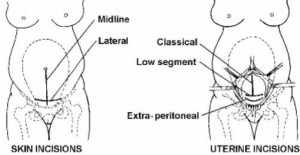a. Definition.
Cesarean section refers to a surgical incision made into the abdomen and uterus to deliver the fetus (see figure 5-1).

b. Indications for a Cesarean Section.
(1) A patient who is unable to deliver vaginally without jeopardizing her life or health or jeopardizing the health of the fetus.
(2) If there is a disproportion between the size of the infant and the mother’s bony birth canal.
(3) If there is previous classical cesarean section or some other extensive uterine or vaginal surgery.
(4) In some women with severe preeclampsia or eclampsia.
(5) In some women with placenta previa or placenta abruption.
(6) When there is fetal distress or impending fetal distress.
(7) In some malpresentation (for example, transverse lie, primipara breech).
c. Nursing Interventions.
(1) Perform preoperative care. Cesarean section is classified as “Major Surgery.” Care is the same as for any abdominal surgery unless an emergency exists or labor has started. Insert a retention catheter prior to surgery. This keeps the bladder empty, prevents trauma to the bladder, and prevents obstruction of the surgical field from a full bladder. Have oxytocin available for administration after delivery.
(2) Perform postoperative care. Care is the same as for any abdominal surgery. Allow the mother to breast feed as soon as she wishes.
(3) Care for the newborn. Have a pediatrician present. A warm crib and resuscitation equipment should be available. Respiratory distress tends to be higher in infants delivered this way. Infants born early do not have a change to adjust to atmospheric pressure changes. Mucous is not expressed from the lungs since the infant did not descent through the birth canal.
